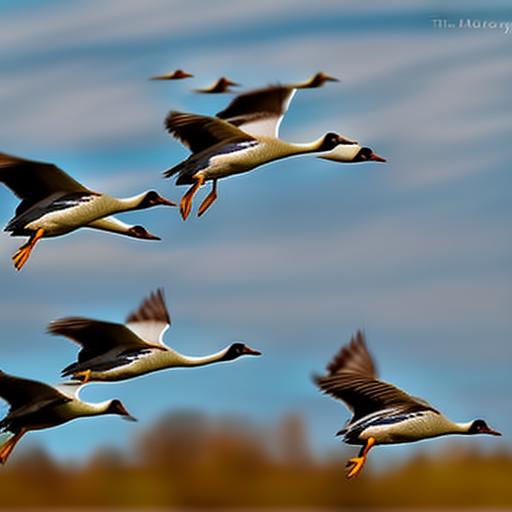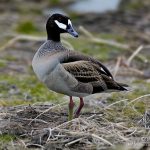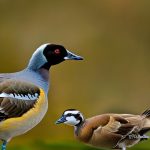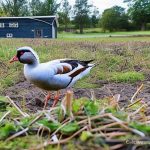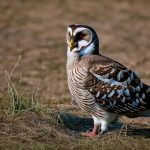Geese are fascinating creatures that have captured the attention of humans for centuries. One of the most intriguing aspects of geese is their flight patterns and behaviors. Understanding these flight patterns is not only interesting from a scientific perspective, but it also has practical implications for human technology and conservation efforts. In this article, we will explore the various flight patterns of geese, why they fly back and forth, how they navigate during migration, the role of leadership in their flight patterns, their unique wing flapping technique, the benefits of flying in a V-formation, their ability to adapt to changing weather conditions, the impact of human activity on their flight behaviors, and the importance of studying their flight patterns for scientific research and conservation efforts.
Key Takeaways
- Geese fly back and forth to communicate and maintain their V-formation.
- Geese’s flight behaviors are important for their survival and migration.
- Geese navigate using a combination of celestial cues and landmarks.
- Leadership plays a crucial role in geese’s flight patterns and decision-making.
- Geese’s unique wing flapping technique helps them conserve energy during flight.
The Fascinating Flight Patterns of Geese
Geese have a unique flight pattern that sets them apart from other birds. They typically fly in a V-formation, with one bird leading the way and the others following closely behind. This formation allows them to take advantage of the aerodynamic benefits of flying in a group. The lead bird creates an upwash of air that helps lift the birds behind it, reducing their energy expenditure. As the lead bird tires, it falls back and another bird takes its place, allowing for efficient rotation of leadership.
In addition to their V-formation, geese have a unique wing flapping technique that further enhances their flight efficiency. Unlike other birds that flap their wings continuously, geese have a distinctive pattern of flapping and gliding. They flap their wings in short bursts and then glide for a period of time before flapping again. This technique helps them conserve energy during long flights.
Why Do Geese Keep Flying Back and Forth?
One behavior that is often observed in geese is their tendency to fly back and forth over a particular area. This behavior can be puzzling to observers, but it actually serves a purpose. Geese engage in this behavior to establish and defend their territory. By flying back and forth, they are marking their presence and warning other geese to stay away. This behavior is especially common during breeding season when geese are nesting and raising their young.
Another reason why geese fly back and forth is to search for food. Geese are herbivores and rely on grasses, grains, and aquatic plants for sustenance. By flying back and forth over an area, they are able to locate food sources and ensure that they have enough to eat.
The Importance of Geese’s Flight Behaviors
Geese’s flight behaviors are not just interesting to observe, they also play a crucial role in their survival. By flying in a V-formation, geese are able to conserve energy during long flights. The lead bird creates an upwash of air that reduces the drag on the birds behind it, allowing them to fly more efficiently. This energy conservation is especially important during migration when geese travel long distances.
In addition to energy conservation, geese’s flight behaviors also help them navigate during migration. Geese rely on landmarks and celestial cues to find their way. By flying in a V-formation, they are able to maintain visual contact with each other, which helps them stay on course. The lead bird also plays a crucial role in navigation, as it is responsible for finding the best route and guiding the flock.
Studying geese’s flight behaviors is important for scientific research because it provides insights into the principles of flight and aerodynamics. By understanding how geese are able to fly efficiently, scientists can apply this knowledge to the development of human technology, such as aircraft design. Furthermore, studying geese’s flight behaviors is also important for conservation efforts. By understanding how geese navigate and adapt to changing weather conditions, conservationists can better protect their habitats and ensure their survival.
How Geese Navigate During Migration
Migration is a remarkable phenomenon that many bird species, including geese, undertake. Geese migrate to find suitable breeding grounds and food sources. During migration, geese rely on a combination of innate instincts and learned behaviors to navigate.
One of the ways geese navigate during migration is by using landmarks. They are able to recognize and remember specific landmarks along their migration route, such as rivers, mountains, and coastlines. By following these landmarks, geese are able to stay on course and reach their destination.
In addition to landmarks, geese also use celestial cues to navigate. They are able to sense the position of the sun and stars and use this information to determine their direction. This ability is especially important during cloudy or overcast days when landmarks may not be visible.
Experience also plays a crucial role in geese’s navigation. Young geese learn the migration route from older, more experienced birds. They follow these experienced birds and learn the route through a process called imprinting. Once they have imprinted on the migration route, they are able to navigate it on their own in subsequent years.
The Role of Leadership in Geese’s Flight Patterns
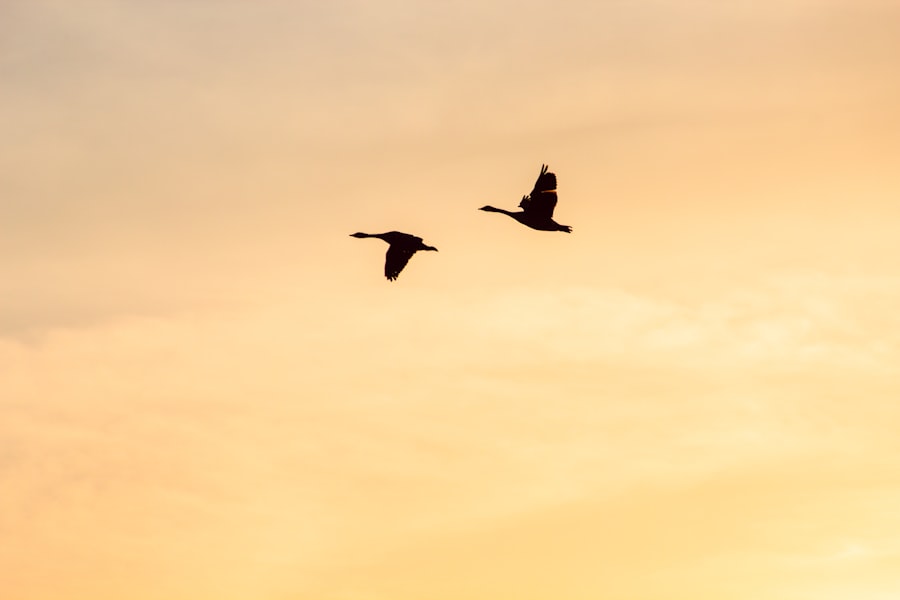
Leadership is a key component of geese’s flight patterns. The lead bird in a V-formation plays a crucial role in guiding the flock and ensuring their safety. But how do geese choose their leader?
Geese choose their leader based on a combination of factors, including age, experience, and physical condition. Older geese with more flight experience are often chosen as leaders because they have a better understanding of the migration route and are more skilled at navigating. Additionally, leaders are typically in good physical condition, as they need to be able to withstand the demands of leading the flock.
The responsibilities of the leader in geese’s flight patterns are numerous. The leader is responsible for finding the best route and guiding the flock. They also set the pace of the flight, ensuring that it is sustainable for all members of the flock. The leader also plays a role in maintaining the V-formation, as they need to adjust their flight path to compensate for changes in wind direction and speed.
Having a strong leader is beneficial for geese’s flight patterns. A strong leader is able to make quick and decisive decisions, which is crucial for the safety and survival of the flock. Additionally, a strong leader is able to maintain the cohesion of the flock and ensure that all members are able to keep up with the pace of the flight.
Geese’s Unique Wing Flapping Technique
Geese have a unique wing flapping technique that sets them apart from other birds. Instead of continuously flapping their wings, geese flap in short bursts and then glide for a period of time before flapping again. This technique helps them conserve energy during long flights.
By flapping their wings in short bursts, geese are able to generate enough lift to stay airborne. Once they have gained enough altitude, they can then glide for a period of time without expending much energy. This gliding phase allows them to rest their muscles and conserve energy.
The wing flapping technique of geese is especially important during migration when they travel long distances. By conserving energy through this technique, geese are able to fly for extended periods of time without becoming exhausted. This energy conservation is crucial for their survival, as it allows them to reach their destination and find suitable breeding grounds and food sources.
The Benefits of Flying in a V-Formation
Flying in a V-formation provides several benefits for geese. One of the main benefits is energy conservation. The lead bird creates an upwash of air that reduces the drag on the birds behind it, allowing them to fly more efficiently. This energy conservation is especially important during migration when geese travel long distances.
Flying in a V-formation also allows geese to maintain visual contact with each other. This is important for navigation, as it helps them stay on course. By flying in a V-formation, geese are able to see the movements of the birds in front of them and adjust their flight path accordingly.
Another benefit of flying in a V-formation is increased communication. Geese are able to communicate with each other through honking sounds. By flying in a V-formation, they are able to hear and respond to each other’s calls more easily, which helps them stay connected and coordinated.
Geese’s Ability to Adapt to Changing Weather Conditions
Geese are highly adaptable creatures that are able to adjust their flight patterns and behaviors in response to changing weather conditions. They have the ability to sense changes in wind direction and speed and adjust their flight path accordingly.
During migration, geese rely on favorable winds to assist them in their journey. They are able to sense changes in wind direction and speed and take advantage of tailwinds, which help propel them forward. By adjusting their flight path to align with the direction of the wind, geese are able to conserve energy and travel more efficiently.
Geese are also able to adapt to changing weather conditions by seeking out suitable habitats. If weather conditions become unfavorable, such as during storms or extreme temperatures, geese will seek out areas that provide shelter and food. They are able to find alternative routes or stopover sites that offer better conditions for resting and feeding.
The ability of geese to adapt to changing weather conditions is crucial for their survival. By being flexible and responsive to their environment, they are able to find suitable habitats and resources that meet their needs.
The Impact of Human Activity on Geese’s Flight Behaviors
Human activity can have a significant impact on geese’s flight behaviors. One of the main ways that human activity affects geese is through habitat destruction and disturbance. As human populations continue to expand, natural habitats are being destroyed or altered, which can disrupt geese’s flight patterns and behaviors.
Habitat destruction can result in the loss of suitable breeding grounds and food sources for geese. This can lead to a decline in their population and disrupt their migration patterns. Additionally, human activity, such as the construction of buildings and infrastructure, can create obstacles that impede geese’s flight paths.
Human disturbance is another factor that can impact geese’s flight behaviors. Geese are sensitive to disturbances and may alter their flight patterns or abandon nesting sites if they feel threatened. Activities such as loud noises, excessive human presence, and disturbance of nesting sites can disrupt geese’s behavior and cause stress.
Studying Geese’s Flight Patterns for Scientific Research and Conservation Efforts
Studying geese’s flight patterns is important for scientific research and conservation efforts. By understanding how geese fly and navigate, scientists can gain insights into the principles of flight and aerodynamics. This knowledge can be applied to the development of human technology, such as aircraft design.
Furthermore, studying geese’s flight patterns is crucial for conservation efforts. By understanding how geese adapt to changing weather conditions and navigate during migration, conservationists can better protect their habitats and ensure their survival. This knowledge can inform the creation of protected areas and conservation strategies that benefit geese and other migratory bird species.
In addition to scientific research and conservation efforts, understanding geese’s flight patterns also has potential benefits for human technology. By studying how geese are able to fly efficiently and conserve energy, scientists can apply this knowledge to the development of more sustainable aircraft designs. This could lead to advancements in aviation technology that reduce fuel consumption and carbon emissions.
Geese’s flight patterns and behaviors are fascinating to observe and study. Their unique flight patterns, such as flying in a V-formation and using a distinctive wing flapping technique, provide insights into the principles of flight and aerodynamics. Understanding geese’s flight behaviors is not only interesting from a scientific perspective, but it also has practical implications for human technology and conservation efforts.
By studying geese’s flight patterns, scientists can gain insights into the principles of flight and aerodynamics that can be applied to the development of human technology, such as aircraft design. Furthermore, understanding geese’s flight behaviors is crucial for conservation efforts, as it helps inform the creation of protected areas and conservation strategies that benefit geese and other migratory bird species.
In conclusion, geese’s flight patterns and behaviors are not only fascinating to observe, but they also have important implications for scientific research and conservation efforts. By understanding how geese fly and navigate, we can gain insights into the principles of flight, develop more sustainable aircraft designs, and protect their habitats for future generations.
If you’re interested in learning more about the care and feeding of waterfowl, you might find this article on “What Should You Feed Ducks?” from Poultry Wizard quite informative. It provides valuable insights into the dietary needs of ducks and offers practical tips on how to ensure their nutritional requirements are met. Whether you’re a beginner or an experienced waterfowl enthusiast, this article is a must-read for anyone looking to keep ducks. Check it out here.
Meet Walter, the feathered-friend fanatic of Florida! Nestled in the sunshine state, Walter struts through life with his feathered companions, clucking his way to happiness. With a coop that’s fancier than a five-star hotel, he’s the Don Juan of the chicken world. When he’s not teaching his hens to do the cha-cha, you’ll find him in a heated debate with his prized rooster, Sir Clucks-a-Lot. Walter’s poultry passion is no yolk; he’s the sunny-side-up guy you never knew you needed in your flock of friends!

